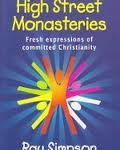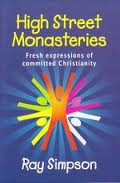Imagine, if you will, a ‘Village of God.’
Over here is a quiet area, with simple cabins for personal retreats, a labyrinth, an inter-faith chapel. Over yonder, some ‘downsized’ business people are getting job application and resume coaching. In the lounge of one of the partner churches, some pastors are studying next Sunday’s readings together. Outside, it’s really busy at the skatepark, and also at the farmers’ market. And, at the literal and figurative heart of the village, is a place of constant, 24-7 prayer.
 This, and much more, is part of Ray Simpson’s pipedream for the church of the future. You can read about it in his “High Street Monasteries” (Kevin Mayhew, Stowmarket, UK, 2009). Simpson is a prolific author, and Founding Guardian of the Community of Aidan and Hilda. He has done as much as anyone in our times to spread the message of Celtic Christianity, and to apply it to the neo-monastic movement, and the “Fresh Expressions of committed Christianity” (the book’s subtitle) that God is raising up in today’s fast-changing society.
This, and much more, is part of Ray Simpson’s pipedream for the church of the future. You can read about it in his “High Street Monasteries” (Kevin Mayhew, Stowmarket, UK, 2009). Simpson is a prolific author, and Founding Guardian of the Community of Aidan and Hilda. He has done as much as anyone in our times to spread the message of Celtic Christianity, and to apply it to the neo-monastic movement, and the “Fresh Expressions of committed Christianity” (the book’s subtitle) that God is raising up in today’s fast-changing society.
Simpson takes up much of the book exploring ancient monasticism, Benedictine and Celtic. He believes its principles are meant not for the few who put on robes, withdraw from the world and cut their hair strangely. This life of discipline, accountability, and devotion to God and the needy is the quality of life to which every disciple of Jesus is called – including the great majority who are not called to live behind monastery walls.
The inspiration for the vision is the Celtic monasteries of the late 1st millennium. Erase your mental image of a walled, rich, celibate, inward-looking monastery. While many Celtic monks and nuns lived in isolated communities or as individual hermits, far more lived in truly vital communities. At their heart was a strong, praying, working body of single and married persons under common vows of purity, simplicity and obedience. However, their fringes were wide open in hospitality. Often, small towns of farmers, craftspeople and others would gather around them. They would be a visible, caring sign of the Reign of God in the whole area. They founded the first hospitals and schools in Britain, at a time of societal collapse. The quality of their life at its best is reflected in Saint Aidan’s beautiful prayer for the community he founded at Lindisfarne, a holy tidal island in northeast England.
Here be the peace of those who do your sacred will;
here be the praise of God by night and day;
here be the place where strong ones serve the weakest,
here be a sight of Christ’s most gentle way.
Here be the strength of prophets righting greed and wrong,
here be the green of land that’s tilled with love;
here be the soil of holy lives maturing,
here be a people one with all the saints above.
Celtic Hymnbook (Kevin Mayhew, Stowmarket, UK)
Such communities are well suited to our own times, where community life is under stress, traditional churches are increasingly discarded, and a ‘spiritual but not religious’ generation looks for expressions of the love of God, the compassion of Christ, and the power of the Spirit that are not tied to a building, or to a 2-hour window on Sunday morning.
Paul Martin is the US Guardian of the Community of Aidan and Hilda; a dispersed, ecumenical community learning from the Celtic saints. He lives in Cannon Falls, Minnesota.

